The best thing you can do when planting an avocado tree in poor soil is to plant on a mound. How? Why? We’ll get there, but first: What is poor soil?
For avocados, poor soil is soil that is not deep or has slow drainage or has high clay content.
Not deep means less than about two feet before you hit something hard — rock or a layer of clay, usually.
Slow drainage means that if you dig a hole and fill it with water, it takes more than a handful of hours to drain out of the bottom of the hole.
High clay content means soils that are classified as clay types (“clay loam,” e.g.).
(What is your soil type? Find out in the USDA’s Web Soil Survey.)
Why plant on a mound
What do these poor soil qualities do that prevents an avocado tree from thriving when planted within them? For shallow soil, the problems are that the tree’s root system will not be able to reach deeply to anchor itself, and the rock or clay barrier below is sometimes not highly permeable, which causes the soil just above it to remain soggy. (More on why soggy soil is dangerous for avocados later.)
So building a mound increases soil depth, but it also means that the tree has that much more aerated, quality soil that the roots can easily penetrate and grow in (unlike through an impervious layer down below).
For the problem of slow drainage, the mound elevates the avocado roots above the soil that drains slowly. When it rains in the winter for a week straight and you have puddles standing in parts of your yard, the avocado up on the mound will dry out first and get oxygen back into its roots. Researchers have estimated that while most plant species need the soil to have about 10 percent air content, avocados need the soil to have about 30 percent air content in order to thrive. (See “Root Asphyxia and Irrigation Management in Avocado Orchards.”)
Mounds for avocados have been tried and studied for decades. It has long been observed that they provide benefits. Here is an early report, “Mounds Aid Root Rot Replants” by Goodall, Ohr, and Zentmyer from the 1987 Yearbook of the California Avocado Society.
Because all other types of fruit trees are less sensitive to slow drainage compared to avocados — I’ve seen many yards where citrus, stone fruits, apples, and pomegranates were growing fine but the adjacent avocados were struggling — don’t make the mistake of thinking that if your dirt is fine for your orange tree it should be fine for your avocado. That’s not always true.
How to plant on a mound
If any one of these poor-soil conditions is present at all, I would plant on a slight mound at least — just a couple inches helps. I would plant up higher and higher the more of these conditions are present and the poorer that each individual condition is.
For example, in my own yard I have sandy loam soil and the soil has fast drainage — no problems there. However, there are some shallow spots here and there. When I dig a hole to plant an avocado, if I find that the good dirt in that area is less than about two shovel heads’ depth, then I plant high accordingly. In other words, if I run into a lot of rocks or some harder, different colored subsoil, then I plant up. How high? As high as is needed to make sure there’s at least two feet of good dirt below the newly planted tree.
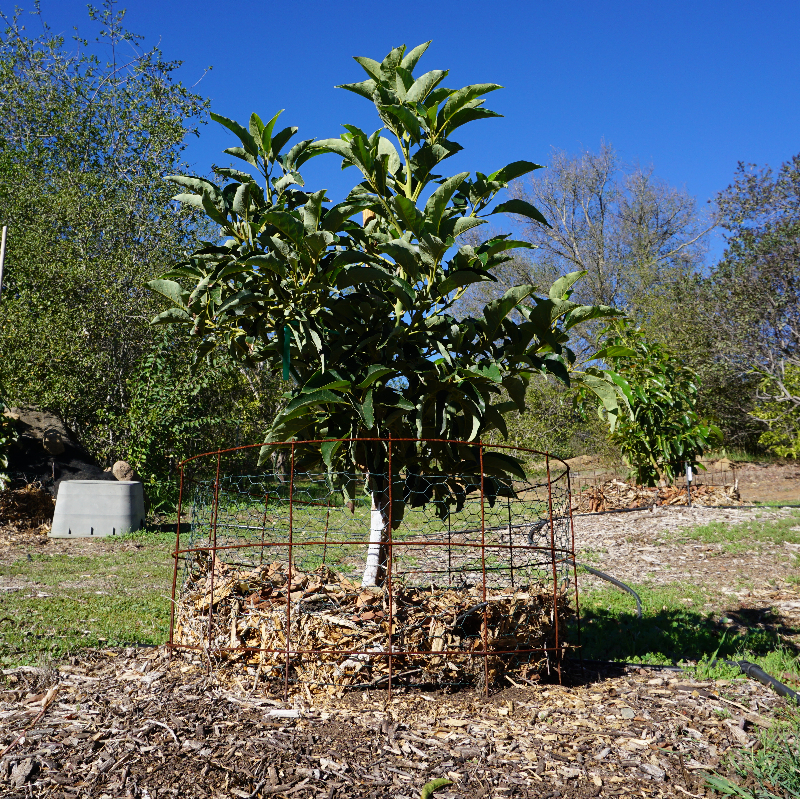
Some yards get scraped by earthmoving equipment when the house is built, and there is almost no good dirt left in certain parts of the yard. In such a yard, you would find the soil shallow for sure, but you also might find it additionally compacted and with poor drainage. This kind of extreme situation certainly calls for an avocado tree being planted on the highest of mounds. A mound that is at least two feet above the surrounding grade might be necessary.
How to build a mound
On avocado farms they sometimes use heavy machinery to form berms that are two or more feet high.
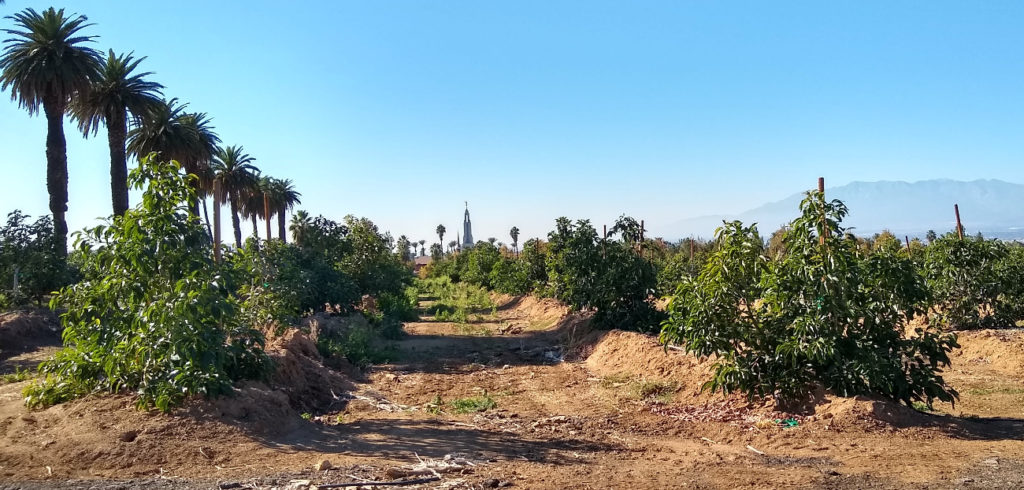
(See a video and discussion of such a berm planting at Cal Poly San Luis Obispo at 49 minutes into the April 2021 Seminar of the California Avocado Society.)
You can imitate this by scraping up dirt from around the planting site or from another part of your yard to build your mound. Sometimes it may be necessary to buy some soil.
Make a mound rather than a pyramid. The first time I built a mound for an avocado tree that I planted over shallow soil, I built the mound with side walls that were too vertical. Rather than a mound, it was more like a pyramid or a volcano. I had a hard time keeping mulch on the mound’s sides and the tree dried out faster than any of my other trees so it was difficult to keep the tree watered sufficiently during summer.
The point is, the sides of your mound should not be too steep. The higher your mound, the wider your mound so that the sides are not too steep.
Examples of dimensions that work are: 1 foot high by 3 feet wide, and 2 feet high by 5 feet wide.
It’s usually best to use mostly real dirt to form your mound, but it is fine to mix some compost and wood chips into the medium also. I’ve even used only compost to build some of my low mounds, and that has worked fine as long as the compost has been aged long enough (a pile sitting for a couple months is long enough).
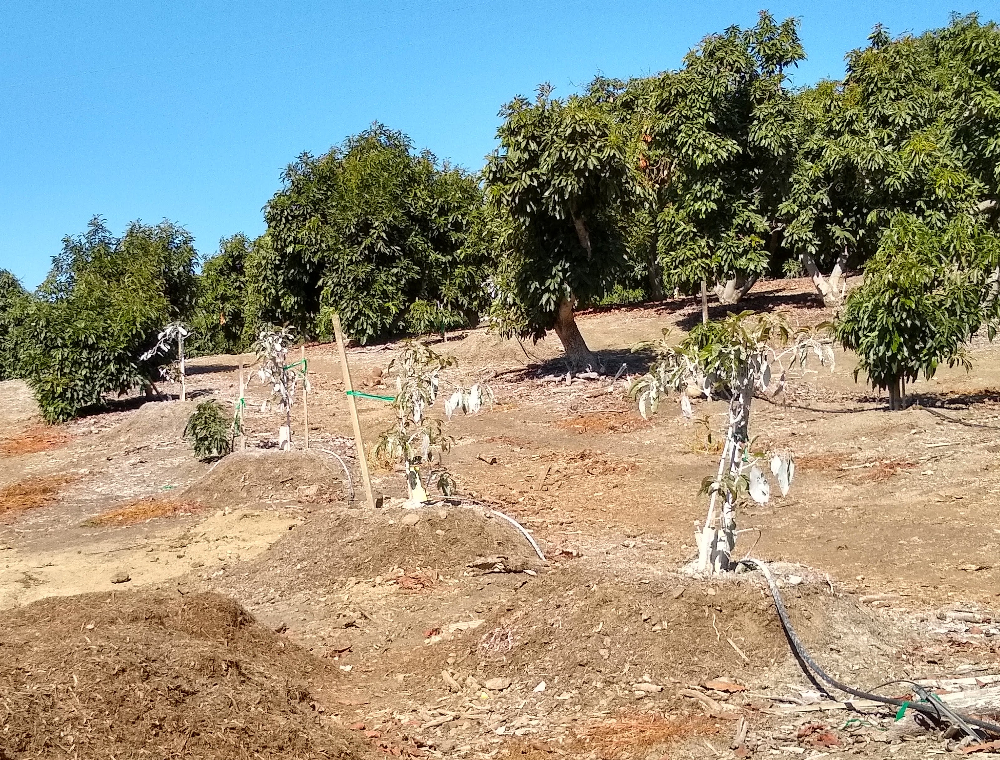
After planting on a mound: mulch
To protect your mound from erosion, you should cover it with mulch. The problem is that this mulch tends to follow gravity and slide down the sides of the mound. The best prevention of this is to erect some netting around the mound. Chicken wire works perfectly.
You almost can’t add too much mulch. Make the netting at least a few inches higher than the top of the mound (the top of the mound being the same height as the base of the trunk of the tree) so that it can contain all of the mulch that you add.
What kind of mulch? Wood chips, leaves, compost, and chopped up tree trimmings are all good.
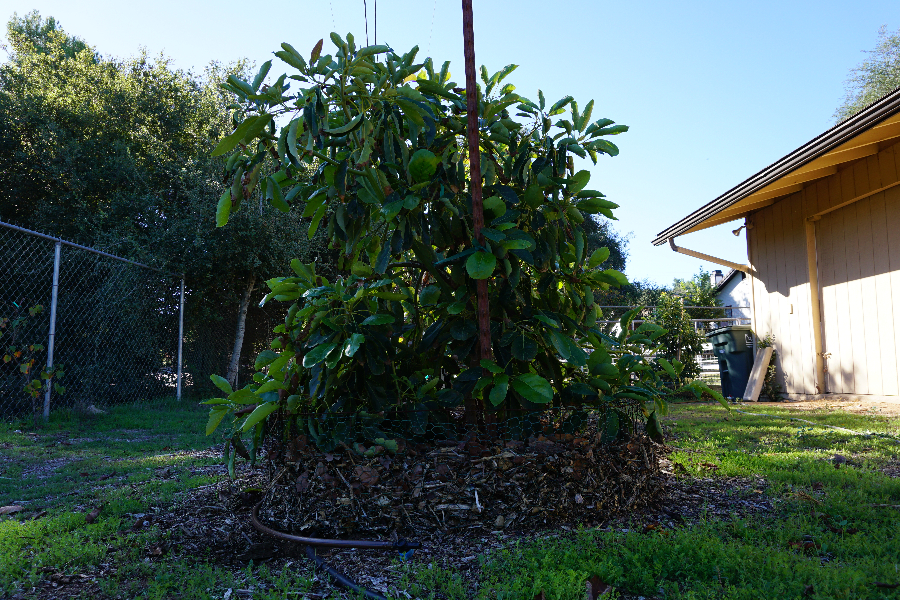
Case study #1
Recently, I helped a friend plant some avocados in his yard in Point Loma, San Diego, and here was our process. We first dug a hole for a drainage test. About a foot down we ran into a layer of clay. So right there we knew we would plant on a mound of some height, but we still had to fill the hole with water to test the drainage.
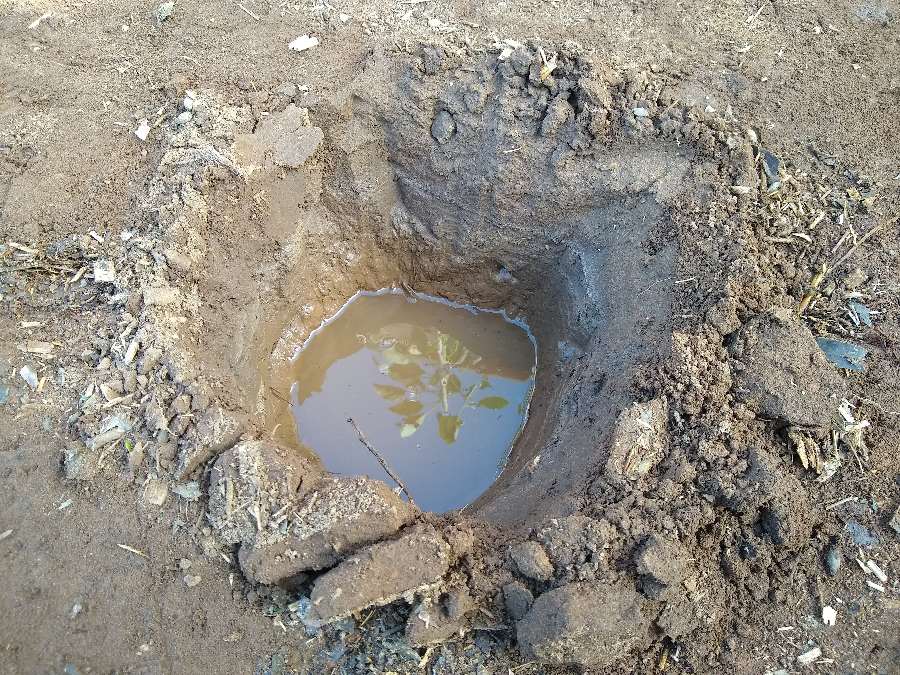
The water disappeared after 1-2 hours so drainage was acceptable. We refilled the hole with dirt almost to the top and placed the tree over it. We scraped soil from the surrounding area to form the base of the mound and then added a bag of “E.B. Stone Top Soil Plus” purchased from a nursery, which is primarily sandy loam dirt.
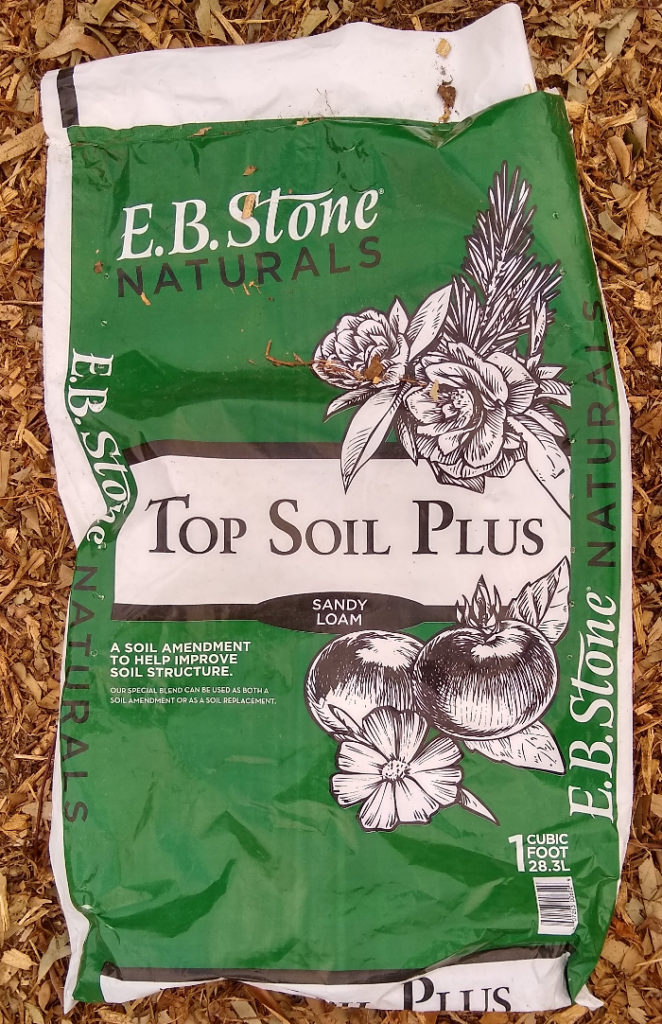
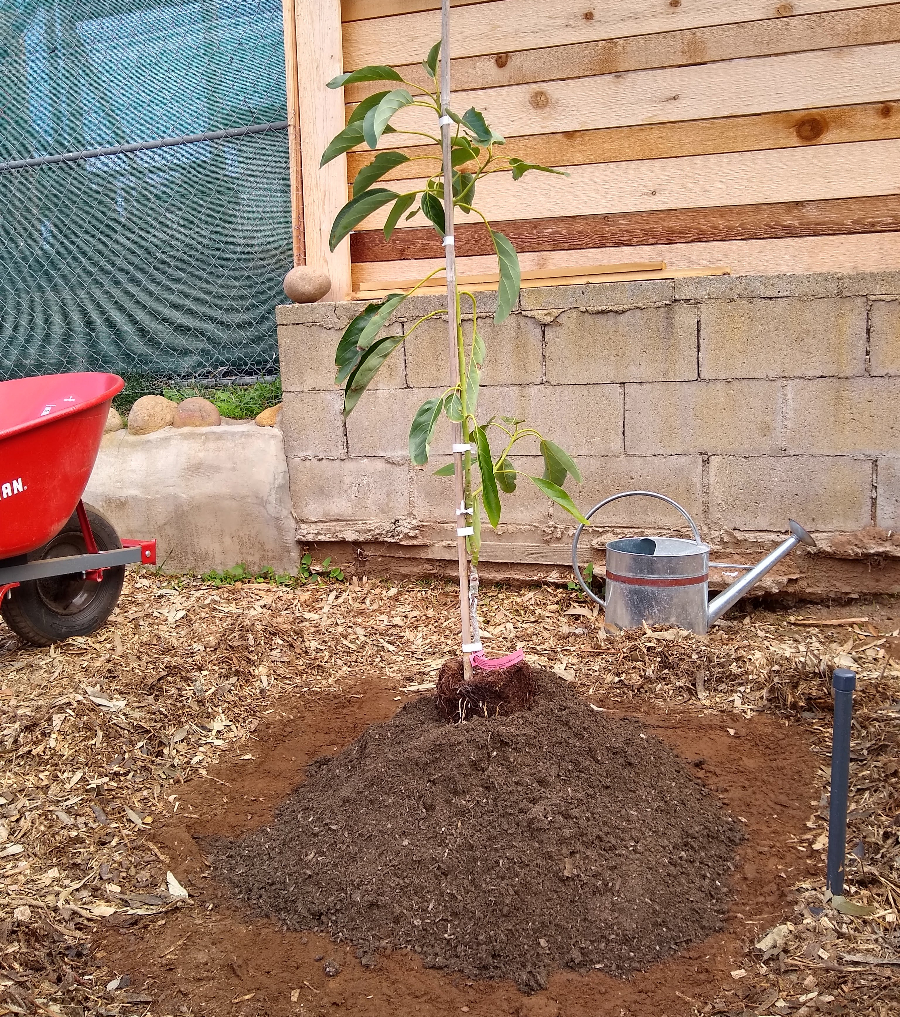
We then completed the mound with compost and wood chip mulch. The tree’s rootball at the top of the mound ended up at just over a foot above grade.
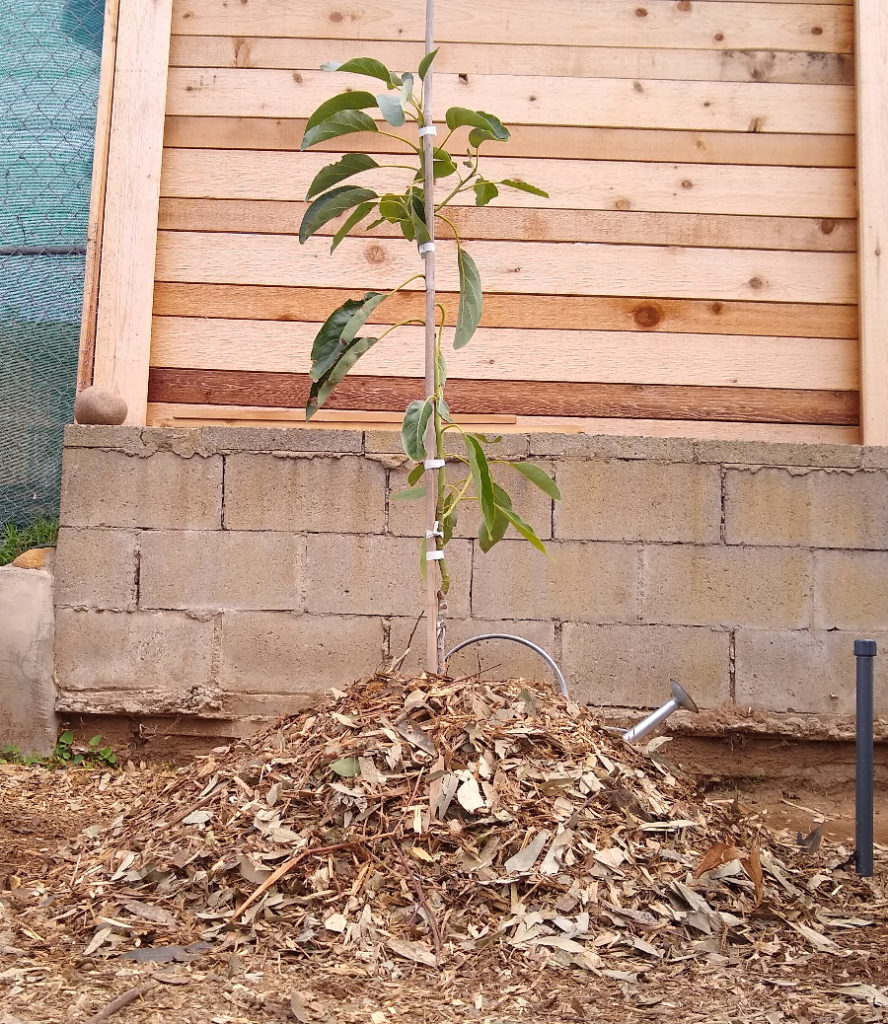
After this, we enclosed the mound with chicken wire and added more mulch. Then we watered the tree in thoroughly.
Case study #2
At a residence in Rancho Santa Fe, the soil is part Altamont clay and part Olivenhain cobbly loam. It is not good for avocados. The owners first planted a set of trees without adjusting for drainage and the trees struggled from the beginning.
Then they invested heavily in improving drainage for a new set of trees. They dug holes about 4′ x 4′ for each tree and laid some gravel at the bottom and connected each hole with a drain to a low spot (a French drain). They filled the holes with mostly native dirt plus a little gypsum.
The trees in 15-gallon containers were then set on top (container removed) and mounds were built around them. The mounds were composed of native dirt, compost, redwood mulch, plus a little fertilizer.
Here is a photo of three of the trees at nine months after planting:
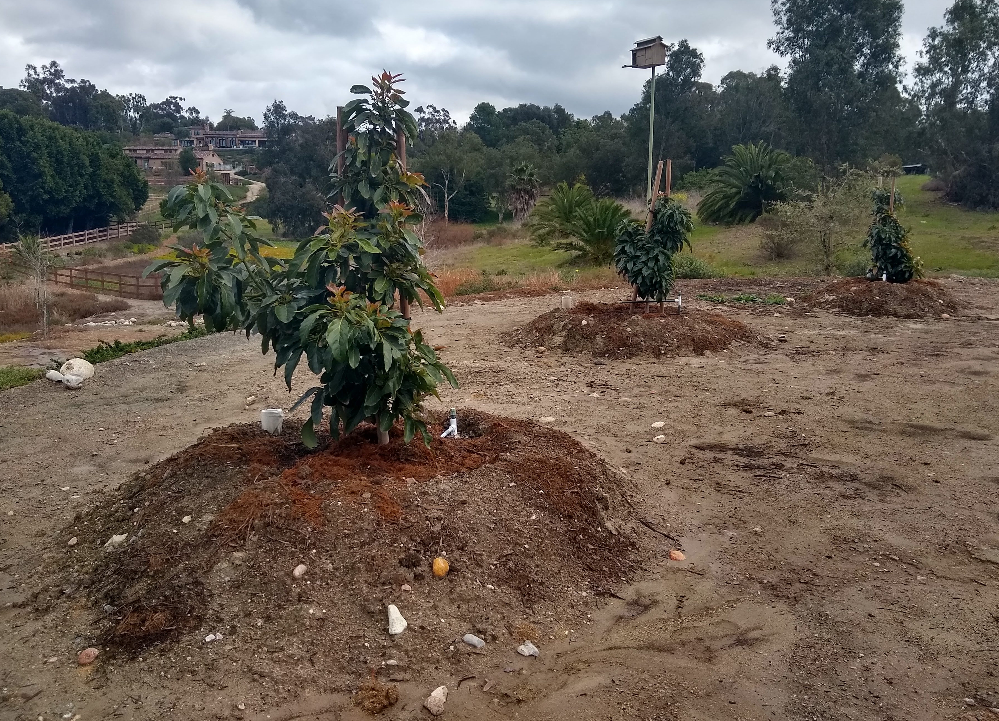
(Here is a third case study that includes a video: “Smart planting of avocado trees where soil is heavy and rainfall is high.”)
After planting on a mound: watering
The good thing about a mound can be that it drains faster and dries out faster than the soil below it, but this fast drainage and drying has to be kept in mind and your watering has to be tailored to it.
In the beginning, for about the first year after planting, you must water the tree right next to the trunk. This is where the roots are. There is no need to water the entire mound.
Also, you must water more often compared to a tree that is planted on flat land or at the same level as the surrounding dirt.
Two final considerations: rootstocks and mulch
Use the best genetics available for your avocado tree, specifically by buying a tree that has a rootstock known to be tough in your soil conditions. This might mean finding a clonal rootstock. Read more about these in my post, “Avocado rootstocks: What do they matter?”
Or you can try a tree on a seedling rootstock of the G6 variety, which is propagated by Maddock Nursery in Fallbrook. Read more about Maddock and nurseries that offer clonal rootstocks in my post, “Where to buy an avocado tree.”
Additionally, keeping a thick layer of mulch on the mound not only prevents erosion but also gives the tree’s roots a more airy, hospitable environment in which to grow and increases the tree’s tolerance of soggy dirt below. (Read more on that in “Factors Affecting Root Rot Control in Mulched Avocado Orchards” by Downer, Faber, and Menge.)
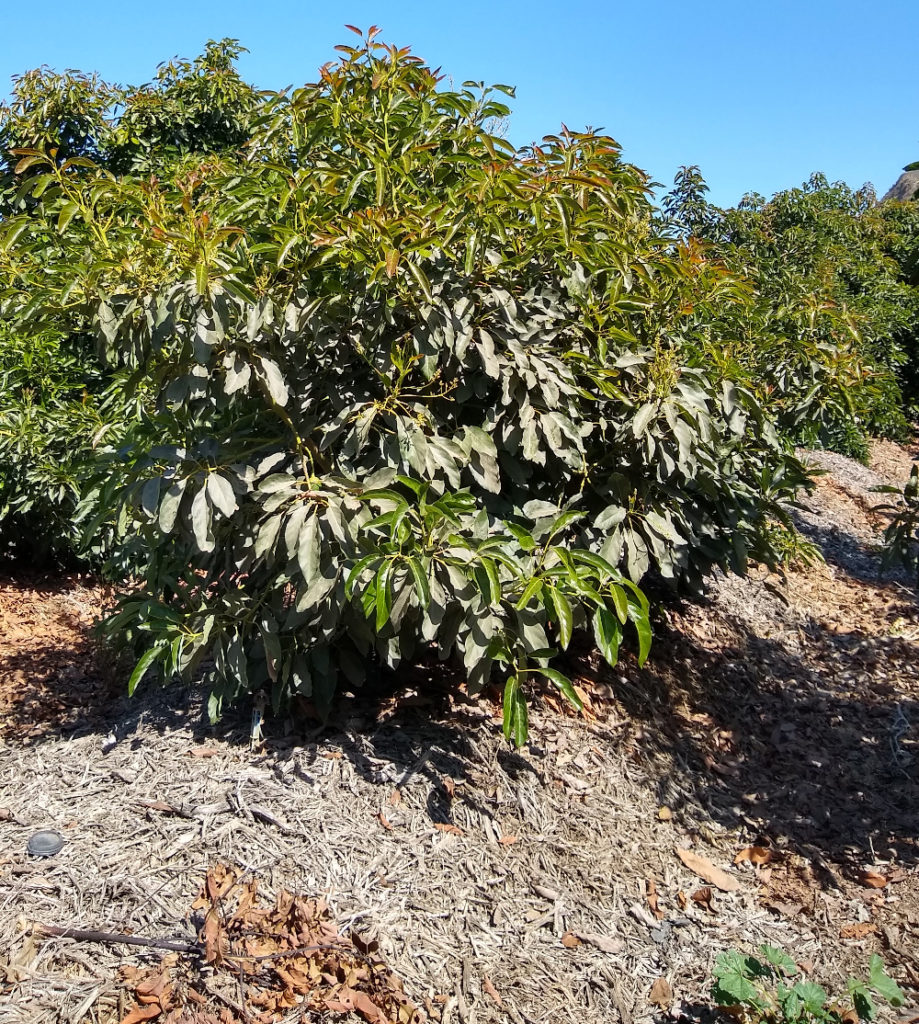
Even if you don’t have ideal soil conditions, you can probably still grow a fruitful avocado tree through modifying your style of planting and the care that you later give to the tree. It takes extra work, but it does work.
For an inspirational example, see the results of Rich’s trees in this video:
For my general post on how to plant avocado trees, see HERE
All of my Yard Posts are listed HERE
You will see no ads on The Yard Posts, and that’s because of your support. Thanks!

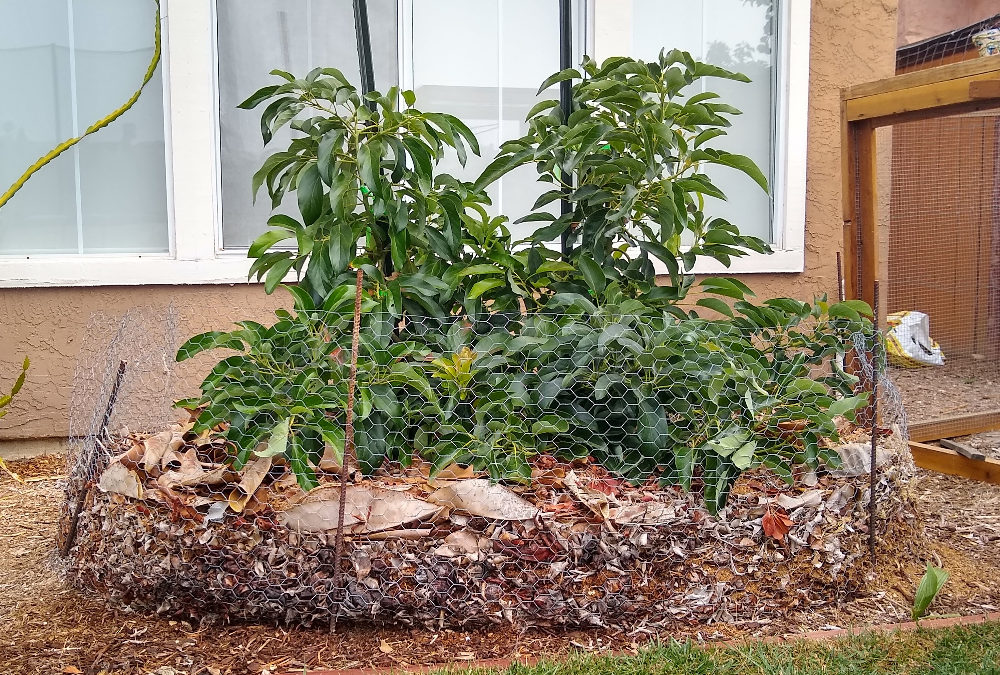
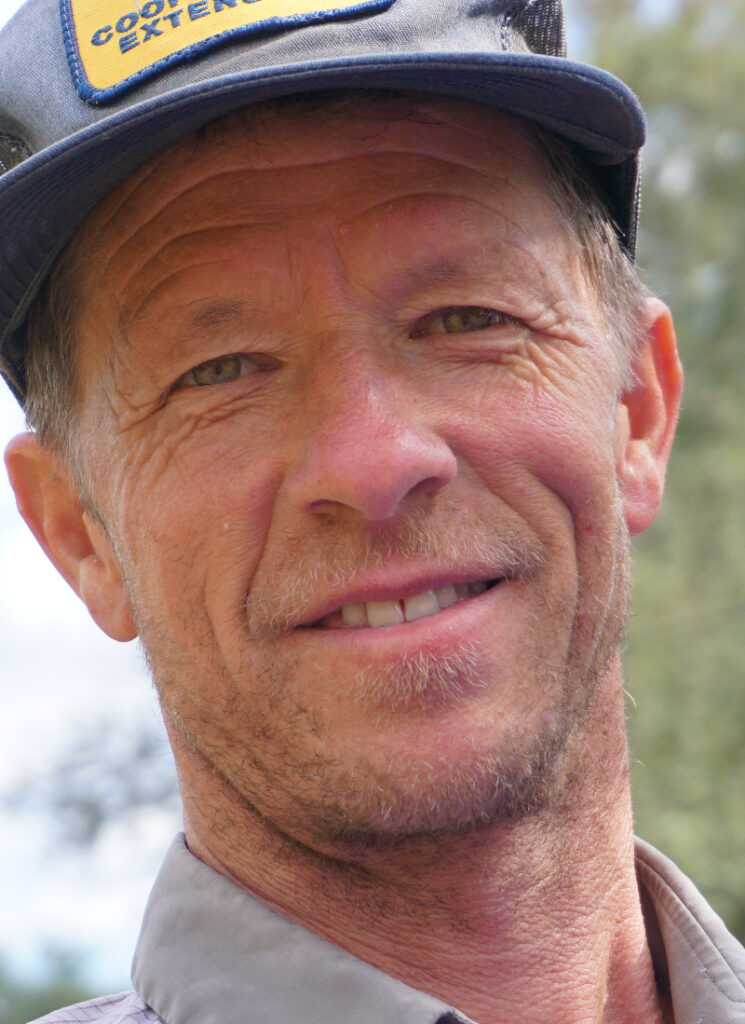

Dear Greg, your article on mounds came just in time before I plant two avocados! I was concerned about including some organic matter in my mounds which are still mostly dirt. I realize I’ve been skimping on mulch and the idea to fence it in is quite radical for me. I can confirm anecdotally that a spot in which two previous avocados died of root root is now growing a healthy tree after making a mound.
What about a kind of solely decomposed granite. The gem tree I purchased in a 15 gallon was grown solely in DG. The farm I bought it from recommended only DVD the mound.
Hi Joe,
A mound composed of solely decomposed granite would work fine, but a tree in such a mound will need to be watered frequently since DG drains so rapidly. I would try to make the mound as wide as possible to reduce how rapidly it dries out and to give the tree more volume to root into.
Greg:
Is sand a poor soil? “poor soil is not deep or has slow drainage or has high clay content.”
I drains great. No rock, Clay layer is down 12-13′ in the sand. No clay content for 12-13′ down. But nutrients???
I live on a barrier island (zone 9a) and would like to avocados in direct sun.
Hi Jim,
I wouldn’t consider sand as a poor soil for avocados since sand is unlikely to cause avocado roots problems with lack of oxygen and infection by Phytophthora.
The main challenges with avocados in sand are that the sand doesn’t hold much water so you have to irrigate relatively often, and the sand doesn’t hold nutrients as well as loam or clay so you have to adjust fertilization accordingly (adding organic matter like compost, manure, and wood chips to sand has shown a lot of benefits).
Thanks Greg. Would you recommend I dig a large hole when time to plant – (After an acclimation period) – and fill it with potting soil or something similar to provide a non-sand nutrient base for the trees? Then mulch.
Dear Jim, Sorry in advance for butting in and Greg will know best. I’ve read that roots want to stay in hole with the most favorable soil. That means the roots will even travel in a circle to stay in good soil. Some say to make a square hole. Books I’ve read say to get tree roots immediately into the native soil. No pampering. I would say to amend the surrounding soil as much as you can and thank the avocado gardening gods for your sandy soil. Avocados don’t like wet feet. 🙂
Randy:
Knowledgeable replies always appreciated!!
Allow me to follow-up two points just for my clarity:
1) No tampering – get tree roots immediately into the native soil.
Okay, I’ve watched several YOUTUBE growers who swear by the need for extended acclimation in pot – even in partial shade.
SO, you’d suggest transplant them to their final resting place quickly!
2) “amend the surrounding soil as much as you can”
Any particular recommended amendments you’d recommend. Type?
Many thanks.
How To Plant An Avocado Tree, Revised
By Julie Frink
1. Place the potted tree where you are planning to plant it.
2. Build up the soil around the pot, up to the level where the stem comes out of the dirt. Tamp the dirt down so it is somewhat firm around the pot. If it is a large pot you can put it into the ground half the depth of the pot.
3. Take the pot out of the dirt mound.
4. Remove the tree from the pot.
5. Put the little tree in the hole in the dirt mound left by the pot.
Little digging is necessary but nice rich dirt for a mound is. When a hole is dug there is a problem of water draining into it (and the root system of the new plant) like a well, or draining out of that area into the surrounding soil, leaching it dry depending on the soil content of the surrounding soil. If you feel better about the process by spading up the ground and making it loose or amending it that would be ok. Many of the new commercial plantings are on berms or raised areas. This has alleviated some of the root rot problems. After planting, all trees settle somewhat so that in several years the trunk area will be lower than when you planted it.
Avocado trees like lots of water but good drainage. They don’t like clean hard dirt under their outstretched branches. They like lots of leaf and wood chip litter to keep their surface roots cool and well nourished. They do not like soil under the tree to be cultivated because it disturbs their surface roots. Most of the avocado feeder roots are in the top few inches of the soil. Avocados do not do well in pots. Very large pots can be used for a few years but that is all. Transplanting from a large pot (like a whisky barrel) is very difficult. Often the root ball falls apart and the tree dies. It is very rare to get good fruit production from a potted avocado tree. It is best to plant from your 1 to 5 gallon potted tree into the ground that the avocado tree will occupy for its entire life.
Don’t fertilize heavily. Too much fertilizer will kill an avocado tree because it has all the delicate feeder roots that are so close to the surface. No fertilizer will not kill a tree. Just the right amount of a very dilute solution of fertilizer will help a tree to be healthy and to grow faster.
If the tree is quite small you might consider protecting it with a tomato cage to keep soccer balls, large birds, children and large dogs from destroying it. Baby trees like shade. Nature has them growing under the limbs of the mother tree. Larger more mature trees like lots of sunshine.
© Copyright 2003, California Rare Fruit Growers, Inc.
Questions or comments? Contact us.
Hi Greg,
Been watching your videos and reading your before I plant my first avocado trees. I’m based in San Diego so I’m close by. I had a few questions that I didn’t see you address in your videos.
1. For 5gal pot trees planted in woody mix, do you plant them as is or try to remove some of the organic matter? Per Gary matsuoka, the organic material will use up the oxygen in the soil and could cause root rot.
2. For small backyards where you want to plant a lot of varieties, how much sq ft or spacing would you recommend. In one of Gary’s videos, he said 5 feet on center is optimal because light doesn’t penetrate past 2 feet into leaves. Not sure if this applies to avocados because they grow a bit wild and the branches lean down. I have some 30ft by 4-5 ft wide retraining walls. Is a 5×5 sq ft space though for avocado trees? Or should I increase the distance between trees? How long do you think they will thrive in this space? What do you think is optimal space per tree for a small backyard?
3. How do you train and prune your avocado trees? I haven’t really seen any videos on this. It seems people just top so the tree doesnt get to tall. Is it realistic to try to prune an avocado to be in a 5×5 space and probably 7 feet tall? Would I lose a lot of production?
5. In your article above, you used “sandy loam dirt”. Do you believe in Gary’s opinion that the soil in the hole would only be mineral based (sand, pumice, perlite, lava rocks, etc)? Organic matter should only be top dressed.
Thanks for all your help, you have been a great resource.
Hi Eric,
1. I’ve never found a problem with planting trees potted in woody mixes or mixes with compost. I’ve planted many like that. I plant them as is.
2. This mostly depends on what you want out of the trees and which varieties you’re planting (how much fruit, how much pruning you want to do, how tall you want them). You can grow a few varieties at 5×5, but others will be impossible to maintain after a handful of years. A realistic tree spacing for the long term is 12 feet apart or maybe 10. But you can plant at 5 or 6 feet apart initially and then remove every other tree after around five years once they crowd.
See: https://gregalder.com/yardposts/how-far-apart-to-plant-avocado-trees/
5. If you are planting in a mound, it works fine to add some plant materials such as wood chips or compost to the mound in addition to the dirt. It’s not necessary, but it is acceptable. I’ve seen this done and done it myself many times. The plant materials do break down over time and the size of the mound thereby shrinks, but the trees love it and grow very well. Adding a mulch of wood chips or compost on top is also helpful to the trees, especially to reduce erosion of the mound.
Hi Greg,
Well I bit the bullet and bought a 25 gallon Hass! I am hoping since I will only have one tree that it will self pollinate or that there will be another one close by in Hancock Park in LA. We have a margarita tree and now we will have our guacamole tree 🙂 Loved reading this post. Just ordered some Gypsum. I am going to dig up an apple tree i planted last year and move it to plant the Hass there. I saw that Rich in his video had planted 2 avocados super close together. I did not realize that you could do that! Thanks again for all your knowledge and insights!
Our past experience in planting Avocado trees have always ended in failure. So, fecently we watch a number of YouTube channels to find out what it was we were doing wrong. Most of what we watched were people who had problems with clay soil and they suggested planting avocado trees on mounds. We have a problem with DG, which pretty much creates the same problem clay does with slow drainage. The holes we dug were two feet deep minimum with 2 ft high mounds that we planted on top of. Tell me about a month so time will tell .
Hi Catryna,
In decomposed granite soil the drainage is very fast unless there is some kind of barrier down below, such as a rock or a clay layer. Therefore, in DG it is not a great idea to plant on high mounds unless there is a drainage barrier below. If you plant on a mound in DG that does not have a drainage barrier below, you are only creating a rooting environment that dries out very quickly and needs to be watered very frequently. That is achievable, but it unnecessarily creates extra work.
Tested my soil and pH came out at 7, phosphorus high, potassium low-moderate, nitrogen low. Any amendment recommendations for when I plant my 15 gallon avocado tree on my 30 degree slope?
Soil is very fast draining due to slope angle. Any advice on improving water retention?
Hi Kevin,
Mulching with wood chips and compost are best at improving the soil’s water-holding capacity.
Avocado grower here. All good advice. We opt for native soil ASAP… BUT we start preparing that native soil months in advance with as much as 20t/A rotted manure, covercrop, or compost. Also a deep ripping (3’ fracture) can help solve drainage issues and last for several years (You can get ripper blades for mini exes). It’s also true that babies like partial shade. Because we can’t do this at an orchard scale, We will paint our trees with a thin clay slurry (kaolin) and a little “sticker”— trunk, leaves and all — which 1) reduces sunburn 2) slows transpiration 3) provides immediate and lasting insect protection. 4) stimulates flush. It turns the trees ghosty— you still want to see some green — and way better than paint which can suffocate leaves. Awesome work Greg.
Thanks for taking the time to share this, Robert. I’ve read about your ranch. It’s helpful to me to hear that you find benefits from spraying with clay even as you’re so close to the ocean.
Greg,
Another great article.
My avocado inventory is Holiday, Gwen, Queen, Kona-Sharwil, Fuerte, Reed, Lamb-Hass, Carmen, Reed. The Old Reed and the Lamb are producing fruit.
My project is to plant southern highbush and rabbiteye plants between the avocado trees; the youngest of which are one season out of sleeves. I have been acidifying the soil with the usual suspects: elemental sulfur, peat moss, cottonseed meal, coffee grounds, etc.
I am trying to hit the narrow band of a sweet spot in acid soil for both of my major plantings.
I have read of people using diluted sulphuric acid, that is a not something that I want to eat, nor introduce to my precious avocado trees.
What do you think about using a vinegar dilution with my very alkaline Costa Mesa tap water to keep the soil Ph down in the plant healthy range?
Other suggestions are welcome.
Thanks
Don
PS: I just received this years calendar, thanks another great one.
I tried planting my avocado trees on a mound. This was about 3 years ago. By then, the mound eventually sinks and my avocado trees are on flat ground again. How would you prevent this? And would this subject them to root rot all over again? Unfortunately, they don’t seem as healthy as they were 3 years ago when first planted.
Hi Jamie,
If you use organic material to build your mound (compost, wood chips), it will settle. If you build the mound with dirt but don’t tamp down the dirt, it will settle. The keys to reducing settling are not using much organic material within the mound and tamping it down before planting into it. That said, there will always be some settling so you must build the mound higher than you want it in the long run.
Also, covering the mound with compost or wood chips will prevent erosion of the mound.
If you’re worried about root rot, the best things you can do at this point are to make sure there’s a layer of at least four inches of wood chips under the trees and check your irrigation to make sure you are not watering while the soil is still soggy a few inches below the surface.
Would 4 inches of compost be ok instead of 4 inches of wood chips? I will definitely try your suggestion, but was wondering if there’s a difference between the two.
Thank you for your advice!
4 months ago I planted a 15 gallon LambHass using THE BLUEPRINT METHOD. I dug a 4 foot deep hole and amended it heavily with compost and recycled potting soil from beds. Flowers are starting to show now in April. I feed it with drip irrigation and was severely overwatering the first couple months. When I look at photos from the day I transplanted up until to now, it seems I’ve lost a considerable amount of leaves and tip burn has grown severely. Have I made too many mistakes (ie not growing on a mound, digging too deep and amending too much) and should repot something else in this hole I’ve created, or with time and proper watering will my tree recover? My other worry is that in years to come, will my roots simply rot away in the deep draining hole I’ve created?
Greg-
For an old avocado that is in 100% clay soil, what what you recommend as a soil amendment? Any brand of soil and/or compost that you’d recommend? Covering about 100 square feet so need it to be somewhat cost effective, but willing to spend as necessary to keep tree healthy 🙂
Hi Kelly,
If an old avocado tree still looks good, then I take the approach of “if it ain’t broke don’t fix it.” Don’t dig in the dirt under the tree, don’t pave, etc. Let all of the leaves fall and remain in place if possible, as that is an excellent mulch.
But it’s always beneficial to such a tree to add some compost or wood chips too. Either is helpful. Wood chips would be my first choice, especially for a tree in clay soil. I’ve noticed that avocado trees in heavy soil love to grow their roots up into wood chips where there are a lot of air spaces.
See this post about where to get wood chips.
I have very heavy clay soil with zero top soil; so I’m building up. I found access to chipped wood trimmings for mulch and have built mounds 4 feet high of mulch ringed with chicken wire. The mulch contains leaves and larger wood chips of various sizes. I have added very little to no dirt to the mulch. Will 5 gal young avocado trees grow in these mounds? What about other citrus trees, will they grow in these mounds? I don’t mind watering often and I’m in a coastal area with high humidity.
Hi Greg,
After failing in my first attempt to grow and avocado tree, I am finally trying again. I got a Reed on Duke 7 rootstock. My yard has a little more than a foot of well draining soil, but under that is rock hard clay. When I was digging my hole to plant the tree, I actually thought it was solid rock at first. So I mounded my tree a bit, but the base is just 20 to 22 inches higher than the clay. I thought that would be enough since the feeder roots are shallow, but ive been reading that if the tap root hits the clay, it will die. Since I have a clonal rootstock, I don’t believe it has a tap root so I’m not sure what to think. I’d rather not dig out the tree and risk damaging any roots, but at 20 to 22 inches from clay, will the tree survive? Thank you for all that you do!
As I’m doing some light night reading, that rock hard clay might actually be sandstone. Either way, I don’t think the roots will be able to penetrate it.
Hi Chris,
It doesn’t matter that much whether there’s a clay or sandstone layer down there. If the texture of the soil changes less than two feet below the surface, the tree is not going to grow as well as it could.
If I were in your situation, I would dig out the tree and replant it on a mound or in another spot in your yard so that there’s three feet of dirt depth. I’ve had to do this a handful of times myself. I know it’s a pain, but I’ve seen that if you don’t do it then the tree struggles forever — and that’s even more of a pain.
Hi Greg,
I really appreciate all the information you have shared. I have been asked to plant avocados on heavy clay which has been compacted by earthwork machinery, with very poor drainage and has reeds growing in it. Basically the worst soil situation. At least it is on a slope so I can put drainage pipes from the bottom of the hole. I understand from what you recommended I will need to have at least 3ft soil depth and a wide mound to sustain the tree for its life. I would like to ask you, should I put roofing iron or something impenetrable at the bottom of the hole, with scoria on top, to prevent the tap root from growing into the clay then rotting ? That is my concern, I can build up high and wide, but the wet clay underneath is my concern.. thank you very much !
Cheers
Dylan
from New Zealand
Wow, Dylan, that does sound like a difficult situation. Drainage pipes should help. I’ve seen this done a few times in similar situations, and the drainage pipes constantly have water dripping from their ends, which tells me they’re effective.
Since the land is sloped, you could also rip trenches up and down the slope to aid the flow of water. I’ve seen this done on avocado farms on slopes with clay soil here to good effect.
I’m guessing you shouldn’t put anything impenetrable at the bottom although I’ve never seen this tried.
What does seem to help is mixing the soil below with the mounded soil a bit at their interface so there is not an abrupt change in type/texture/structure. This mixing should help water move across the interface better. It should reduce the chances of water sitting on top of that hard clay upon which the mound was built.
While it’s true that avocado trees grow best in soil that is hospitable (not soggy) to maximum depth, they can grow fine with only about 3 feet of hospitable soil. What seems to happen is that the roots don’t grow deeper or rot at the inhospitable (soggy) depth, but since there’s sufficient hospitable root zone above there the tree gets by just fine.
Hi Greg,
I have a reed I started from a seed. It’s now about 6’ tall and doing well in a large wood half barrel. I want to transfer to the ground. Can I plant it on a slope in my yard? I don’t have a good space on flat ground. I’m in the Corona area of Ca. Thanknuou
Certainly, Jim. Most of my avocado trees are planted on a slope. Just don’t make the mistake of planting it in a basin; plant it at grade or even slightly above. Use the dirt from the hole to make a lip on the downslope side. Also, add mulch in order to reduce water runoff.
Hi , I have a burning question. Can you replace a dead root rotted avocado tree with another new avocado tree in same spot? New preventative measures would be taken like extra mounding , better water control and phos acid spraying. Just wondering if its still possible